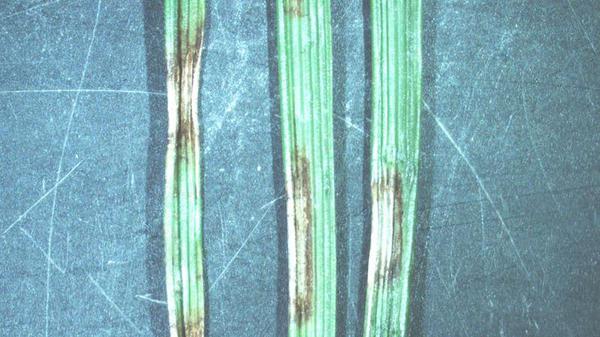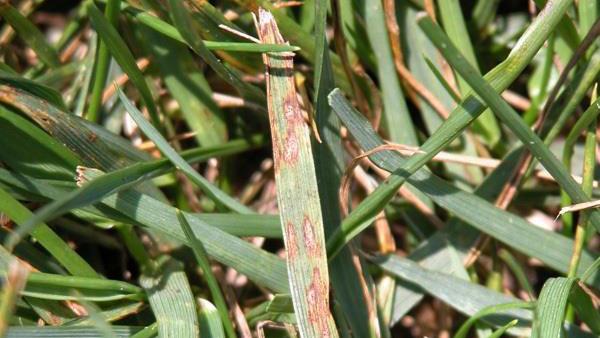Symptoms
Net blotch is a disease that occurs on tall fescue during cool, wet, and cloudy periods in the spring or early summer. Net blotch is a ‘Helminthosporium’ disease, which is a complex of diseases caused by fungi that produce large, cigar-shaped spores. Symptoms of net blotch appear as tiny, brown spots on the leaves. As the lesions expand, they become oval or square and coalesce to form a net-like pattern on the leaf. From a distance, net blotch appears as a general thinning of the turf stand that is yellow or brown in color.
Development Factors
Net blotch is one of several Helminthosporium diseases which survive in thatch during periods that are unfavorable for disease development. These fungi are most active during periods of cool (60 to 65°F) and wet weather, but some are able to cause disease whenever temperatures are above freezing.
Net blotch is most severe on turf that is growing slowly due to adverse weather conditions or improper management practices. Shaded areas with little or no air movement result in weak turf and extended periods of leaf wetness that favor disease development and plant infection. Deficient or excessive nitrogen, excessive thatch, extended periods of leaf wetness, drought stress, and low mowing heights are factors that encourage the development of Helminthosporium diseases.
Certain cultivars of turfgrasses are very susceptible to injury from Helminthosporium diseases while many of the newly released cultivars have exhibited good resistance.
Cultural Control
Use turfgrass cultivars with resistance to this disease when available. Refer to the results of cultivar evaluation trials operated by the National Turfgrass Evaluation Program or local Universities for cultivars with leaf spot resistance that perform well in your area. When planting cool-season turfs, use blends and mixtures of multiple species and/or varieties whenever possible.
Fertilize to meet the nutritional needs of the turf but avoid over-stimulation and the development of lush, succulent growth. Do not apply more than one pound of nitrogen per 1,000 square feet in a single application. Tall fescue should be mowed to a height of 3 to 3.5 inches. Keep the mower blades sharp to prevent open wounds through which the fungus can enter.
Reduce extended periods of leaf wetness by watering deeply but infrequently to wet the entire root zone. Do not irrigate just before or after sunrise, and ensure good surface and soil drainage. Remove unwanted vegetation that impedes air movement and prune trees to allow for light penetration. Power rake or dethatch to remove excessive thatch and reduce the potential for pathogen survival.
Chemical Control
Net blotch can be controlled on a preventative or curative basis. Applications should be made in the early stages of disease development for best results. Susceptible turfgrasses should be monitored regularly for disease development during cool and wet weather conditions.
Species Data
- HOST SPECIES
- tall fescue
- MONTHS WITH SYMPTOMS
- March to June, September to November
- STAND SYMPTOMS
- irregular distribution across turf stand
- FOLIAR SYMPTOMS LOCATION / SHAPE
- FOLIAR SYMPTOMS COLOR
- yellow, brown
- ROOT / CROWN SYMPTOMS
- none
- FUNGAL SIGNS
- none
Publication date: Nov. 9, 2017
Recommendations for the use of agricultural chemicals are included in this publication as a convenience to the reader. The use of brand names and any mention or listing of commercial products or services in this publication does not imply endorsement by NC State University or N.C. A&T State University nor discrimination against similar products or services not mentioned. Individuals who use agricultural chemicals are responsible for ensuring that the intended use complies with current regulations and conforms to the product label. Be sure to obtain current information about usage regulations and examine a current product label before applying any chemical. For assistance, contact your local N.C. Cooperative Extension county center.
N.C. Cooperative Extension prohibits discrimination and harassment regardless of age, color, disability, family and marital status, gender identity, national origin, political beliefs, race, religion, sex (including pregnancy), sexual orientation and veteran status.



